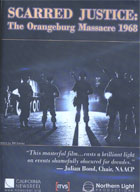
Scarred Justice: The Orangeburg Massacre 1968 2009
Distributed by California Newsreel, Order Dept., PO Box 2284, South Burlington, VT 05407; 877-811-7495 (toll free)
Produced by Bestor Cram and Judy Richardson
Directed by Bestor Cram and Judy Richardson
DVD, color, 57 min.
Sr. High - Adult
African American Studies, History
Date Entered: 07/15/2009
Reviewed by Timothy W. Kneeland, History and Political Science Department, Nazareth College of Rochester, Rochester, NYScarred Justice is a revealing account of a long neglected chapter in the civil rights struggle. On the night of February 8, 1968 three African American students were killed and dozens shot by members of the South Carolina State police and Orangeburg Sheriff’s department during a peaceful demonstration on the State College campus in Orangeburg, South Carolina. Although the Justice Department suspected that the authorities had violated the civil rights of the students, FBI agents in collusion with local and state police conducted a perfunctory investigation that covered up any liability by police agencies. Due to community efforts nine policemen were put on trial but the outcome was predetermined and all police involved were exonerated. Instead, one of the student leaders who had been wounded by authorities, Cleveland Sellers, was labeled an outside agitator and militant whose quest for “black power” had incited the riot. Predictably, Sellers was tried, convicted, and sentenced to a year of hard labor.
The filmmakers, using news footage, interviews, and even dramatic reenactments, produce a superb documentary which details the events leading up the violence but also the conditions which sparked the tragedy. The specific incident was sparked by an attempt to integrate a local bowling alley but occurred at the time when the civil rights movement shifted from a call for the integration of African Americans into society, to a call for political and social power. Roland Haynes, one of the witnesses to the massacre at Orangeburg, notes that this shift was partially generational as well as tactical. SNCC leader Stokely Carmichael who famously coined the phrase “black power” did not rule out violence as a means to gain this. Race riots in Detroit and elsewhere increased the perception by white authorities that black power really meant militant action. Just days before the murder of the college students by the police, the bowling alley protest had spilled over into the wider community when some students destroyed white owned property in the vicinity of the bowling alley. Authorities were also aware that one of the student protest leaders, Cleveland Sellers, was a close friend of Carmichael and former member of SNCC. These two facts combined with their preconceived notions of the black power movement led them to overreact and they brought the South Carolina National Guard to Orangeburg, established a curfew for students at the two black colleges in town, and surrounded the campuses with police. Students responded by building a bonfire. When authorities came on campus to put out the fire some claimed to have heard gunfire and for eight seconds at least nine officers began discharging their shotguns into the unarmed students. No evidence exists that students were in possession of any firearms and most eyewitnesses verify that there was no gunfire. Although South Carolina granted Cleveland a full pardon in 1993, to this day the state has not acknowledged or accepted its guilt for the deaths of the three young men killed: Samuel Hammond, Delano Middleton, and Henry Smith, and the dozens of others who were shot.
The pacing of this film is nearly perfect, the narration flawless and the editing tightly controlled so that there are few wasted moments in the 57-minute documentary. The pacing and direction falter only when filmmakers focus on the meaning of the Orangeburg massacre nearly forty years after. Since South Carolina has yet to acknowledge its guilt there is still no closure for this incident, leaving the film with an unsatisfactory conclusion.
Highly recommended Sr. High School – Adult.